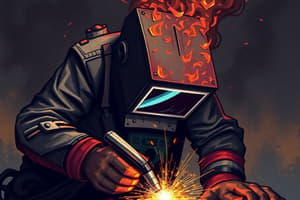Podcast
Questions and Answers
What is the primary function of a welder?
What is the primary function of a welder?
- To design blueprints for construction projects
- To cut materials into specific shapes
- To paint and finish metal surfaces
- To join materials through welding processes (correct)
Which type of welder is most suitable for thin materials and is easy to learn?
Which type of welder is most suitable for thin materials and is easy to learn?
- Flux-Cored Arc Welder
- MIG Welder (correct)
- Stick Welder
- TIG Welder
What type of protective gear is essential for welders?
What type of protective gear is essential for welders?
- Hearing protection and face masks
- Helmets, gloves, jackets, and boots (correct)
- Aprons and knee pads
- Hard hats and goggles
Which welding method is known for providing high precision and is best for delicate materials?
Which welding method is known for providing high precision and is best for delicate materials?
What is a critical skill that a welder must possess?
What is a critical skill that a welder must possess?
What is an important safety practice when welding?
What is an important safety practice when welding?
Which certification organization is commonly associated with validating welding skills?
Which certification organization is commonly associated with validating welding skills?
What trend is affecting the future of welding careers?
What trend is affecting the future of welding careers?
Flashcards are hidden until you start studying
Study Notes
Overview of Welders
- Definition: Welders are skilled tradespeople who join materials, typically metals or thermoplastics, through welding processes.
- Role: Essential in construction, manufacturing, shipbuilding, and other industries requiring metal fabrication.
Types of Welders
-
MIG Welder (Metal Inert Gas)
- Uses a continuous wire feed and inert gas for shielding.
- Suitable for thin materials and easy to learn.
-
TIG Welder (Tungsten Inert Gas)
- Uses a non-consumable tungsten electrode and inert gas.
- Provides high precision and is best for thin and delicate materials.
-
Stick Welder (Shielded Metal Arc Welding)
- Uses coated electrode rods that melt and create a weld pool.
- Versatile and effective for outdoor and heavy-duty work.
-
Flux-Cored Arc Welder
- Similar to MIG but uses a tubular wire filled with flux.
- Good for welding in windy conditions and thicker materials.
Skills Required
- Technical Skills: Knowledge of welding techniques, metallurgy, and tool operation.
- Physical Skills: Good hand-eye coordination, manual dexterity, and physical stamina.
- Safety Awareness: Understanding of safety protocols and use of protective equipment.
Equipment Used
- Welding Machine: Provides the necessary current and voltage.
- Protective Gear: Helmets, gloves, jackets, and boots to protect against heat and sparks.
- Welding Rods/Wires: Specific for each welding process used for joining materials.
Safety Practices
- Always wear appropriate protective gear.
- Ensure proper ventilation in the workspace.
- Regularly inspect equipment for faults.
- Be aware of fire hazards and avoid flammable materials nearby.
Certification and Training
- Training Programs: Offered by vocational schools, technical colleges, or apprenticeships.
- Certifications: Available through organizations (e.g., AWS, ASME) to validate skills and improve job prospects.
Career Opportunities
- Industries: Construction, automotive, aerospace, manufacturing, and pipeline industries.
- Advancement: Opportunities for specialization, supervisory roles, or starting a welding business.
Trends in Welding
- Automation: Increasing use of robotic welding in manufacturing.
- Green Technologies: Emphasis on eco-friendly welding processes and materials.
- Skills Gap: Ongoing demand for trained welders due to workforce shortages.
Conclusion
- Welders play a crucial role in various industries, requiring a blend of technical skills, safety awareness, and continuous learning to adapt to new technologies.
Overview of Welders
- Welders are tradespeople skilled in joining materials, typically metals or thermoplastics, using welding processes.
- They are critical in industries such as construction, manufacturing, and shipbuilding, where metal fabrication is essential.
Types of Welders
- MIG Welder (Metal Inert Gas): Employs a continuous wire feed with inert gas shielding; ideal for thin materials and relatively easy to master.
- TIG Welder (Tungsten Inert Gas): Utilizes a non-consumable tungsten electrode and inert gas, offering high precision, ideal for thin and delicate materials.
- Stick Welder (Shielded Metal Arc Welding): Operates with coated electrode rods that melt to create a weld pool; versatile for outdoor and heavy-duty welding tasks.
- Flux-Cored Arc Welder: Functions similarly to MIG but employs a tubular wire filled with flux; effective for thicker materials and in windy conditions.
Skills Required
- Technical Skills: Proficiency in welding methodologies, understanding of metallurgy, and adeptness in tool operation.
- Physical Skills: High hand-eye coordination, manual dexterity, and overall physical stamina are vital.
- Safety Awareness: Essential knowledge of safety protocols and proper use of protective equipment to prevent workplace accidents.
Equipment Used
- Welding Machine: Supplies essential current and voltage to perform welding tasks.
- Protective Gear: Includes helmets, gloves, protective jackets, and boots to shield against heat and sparks during welding.
- Welding Rods/Wires: Specialized rods and wires are necessary for different welding techniques to ensure material joining.
Safety Practices
- Mandatory usage of appropriate protective gear at all times.
- Need for adequate ventilation in the workspace to reduce hazardous fumes.
- Regular inspection of welding equipment to ensure safety and functionality.
- Awareness of potential fire hazards and elimination of flammable materials in proximity to the workspace.
Certification and Training
- Training Programs: Can be pursued at vocational schools, technical colleges, or through apprenticeships for hands-on learning.
- Certifications: Credentials from organizations, such as AWS and ASME, enhance skill validation and improve employment opportunities.
Career Opportunities
- Welders find roles across multiple sectors including construction, automotive, aerospace, manufacturing, and pipeline industries.
- Career progression may lead to specialization, management roles, or the establishment of independent welding businesses.
Trends in Welding
- Automation: Increasing implementation of robotic welding systems in manufacturing settings to enhance efficiency.
- Green Technologies: Growing focus on eco-friendly welding techniques and materials that minimize environmental impact.
- Skills Gap: Persistent demand for trained welders due to shortages in the workforce, creating job opportunities.
Conclusion
- The welding profession significantly impacts several industries, necessitating a combination of technical skills, safety consciousness, and ongoing knowledge acquisition to keep pace with evolving technologies.
Studying That Suits You
Use AI to generate personalized quizzes and flashcards to suit your learning preferences.




